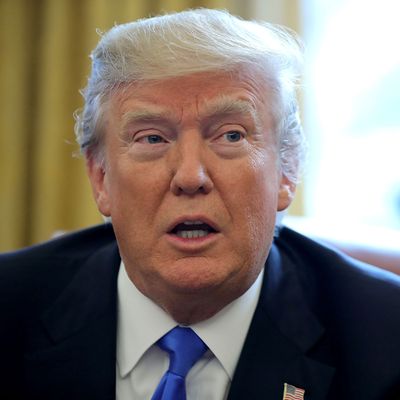
During the 2016 campaign, the Democratic National Committee and Clinton campaign hired a “strategic intelligence” firm to dig up dirt on Donald Trump. That firm, Fusion GPS, hired a former member of Britain’s secret intelligence service — one who had spent years spying on Russia — to investigate possible links between the Trump campaign and the Kremlin. That spy, Christopher Steele, found quite a few. Months later, the FBI got wind of the resulting “dossier;” months after that, America learned that the FBI was investigating ties between Trump and Russian interference in the 2016 election.
Since then, the “Steele dossier” has been an object of bipartisan fascination. For the left, the document told a thrilling — and, at times, filthy — story about how Vladimir Putin turned Trump into his puppet (possibly by capitalizing on the mogul’s rabid urolagnia). For the right, it represented the rotten core of the Russia probe: proof that the president’s political enemies paid some shiftless ex-spy to first write a bunch of lies about Trump — and then to leak those lies to anti-Trump FBI agents, who proceeded to mount a bogus investigation as means of executing a deep-state coup.
Congress decided to look into the matter. Last August, Fusion GPS founder Glenn R. Simpson gave hours of testimony of the Senate Judiciary Committee. In recent weeks, congressional Republicans have argued that the origins of the Steele dossier — and its relationship to the FBI’s investigation into Trump — are deeply concerning matters that the American people deserve more information about. House conservatives have insinuated that the Clinton campaign and Democratic members of the FBI might be involved in a conspiracy against the president so far-reaching, it threatens the survival of rule of law in the United States — and that Fusion GPS is at the center of said conspiracy.
And yet, despite encouragement from their Democratic colleagues, Senate Republicans have refused to release Glenn Simpson’s sworn testimony on these subjects.
So, on Tuesday, Democratic senator Dianne Feinstein unilaterally released it for them. And now, it’s easy to see why the GOP preferred demanding answers over providing them — their alt-collusion narrative does not benefit from sunlight.
Here are three bombshell claims in Simpson’s newly released testimony:
1. The FBI was looking into Trump’s Russia ties before they got wind of the Steele dossier — because a whistle-blower from the candidate’s inner circle had already snitched to them.
In June 2016, Steele’s sources (allegedly) told him that the Kremlin was regularly passing intelligence on Hillary Clinton to the Trump team through then-campaign manager Paul Manafort — and that Putin might be in a position to control Trump through blackmail material (the pee tape). Steele decided to alert the FBI to this information. When he did, according to Simpson’s testimony, the bureau “believed Chris’s information might be credible because they had other intelligence that indicated the same thing, and one of those pieces of intelligence was a human source from inside the Trump organization.” Simpson suggested that, in his understanding, this source was moved to share information for reasons of conscience.
However, all available evidence suggests that Simpson made a faulty presumption. Recently, the New York Times reported that the FBI first began investigating the Trump campaign after one of its aides, George Papadopoulos, “made a startling revelation to Australia’s top diplomat in Britain” during “a night of heavy drinking” — “Russia had political dirt on Hillary Clinton.”
If that reporting holds up, then the “human source from inside the Trump organization” did not know that he was a human source. It’s possible, however, that Simpson was referencing a second, intentional informant.
Regardless, the linchpin in the GOP’s conspiratorial case against the Russia investigation is that it was triggered by opposition research funded by Hillary Clinton. It’s unclear why this would discredit the investigation, even if it were true — multiple members of the Trump campaign, including the president’s son and son-in-law, have admitted to accepting ostensible aid from the Russian government. But we no longer need to quibble about the implications of the GOP’s premise, because that premise is false.
2. Steele stopped cooperating with the FBI in late October, out of fear that the bureau was biased in Trump’s favor.
On October 31, 2016, the New York Times published a (now infamous) story, “Investigating Donald Trump, F.B.I. Sees No Clear Link to Russia.” The fact that the FBI would leak a story so useful to the Trump campaign — despite all of the evidence contradicting its premise — led Steele to feel that “he didn’t know what was happening inside the FBI and there was a concern that the FBI was being manipulated for political ends by the Trump people and that we didn’t really understand what was going on. So he stopped dealing with them,” according to Simpson.
The GOP’s alt-collusion theory rests on the idea that the FBI and mainstream news media are so biased against Trump, they’ve made a mountain out of a molehill. Simpson’s testimony suggests that, at least when it really mattered (during the 2016 campaign), the opposite was true.
3. Simpson’s lawyer claimed that “Somebody’s already been killed as a result of the publication of this dossier and no harm should come to anybody related to this honest work.”
The claim has few implications for the GOP’s conspiracizing, and it’s unclear who, or what he’s referring to. But the implication seems to be that a source was killed.






























